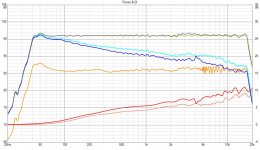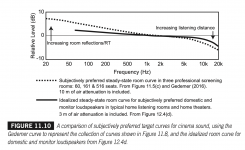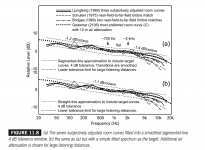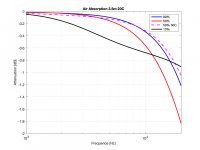You've lost me. 🙂
It's not that difficult 😉, 2 front mains, goal there is to get lots of direct sound, and have the first reflections absorbed or avoided. I use no horns but do have a somewhat controlled DI:
Orange line is the predicted in room curve, red is DI. It's actually somewhat comparable to what the Genelec etc. achieve. This orange prediction is with floor and ceiling reflections turned on, that's where it would differ from having speakers like the Genelec in a room.
To accompany that mains setup I use the ambience setup, made up by the following components:
2 Ambience channels, no (or not much) direct sound from them but let them diffract/reflect off of the environment and have them arrive (at LP) from lateral angles. Delayed, band passed, with a specific mix and with reverb added.
This was drawn up by Pano once, to get a picture of what it is I'm doing:

(this includes mid/side EQ on mains)
Back to the regular scheduled program 😉.
Attachments
Last edited:
Yes, i've also heard the "4 tunnel sound" on some tracks, from the same 4 speakers that could sound very immersive on other tracks. (Had a big 5.1 setup for a while.)
I like your description… 4-tunnels...
It's very weird how it's so music-type and track dependent....
The Astral Spatial demo was in partnership with Alcons. Astro Spatial Audio | Creativity Through Simplicity
Better technical info in this promo.
Crazy the special effects and also the natural sound capability at their infocomm setup
(Oh, if there's any driver that might move me away from CD's on horns, it could be the Alcon ribbons. They won't sell the drivers individually 🙁)
Synergies' tunnel effect appears to be strongly related to horn depth and dispersion.
The large J(ericho) 1-94s are hardly affected by this phenomenon.
Alcon's Pro-Ribbon drivers are the brainchilds of Philip ‘Dr. Phil’ de Haan.

Basically further developments of the Philips/Stage Accompany SA8525/26 and SA8535 isophasic planar drivers.

Last edited:
In this short Meyer Spacemap promo vid, the lady singer walked around inside the entire audience area, with her singing sounding like it was coming from her where ever she was.
I don't know how much of the audience area heard the same phenomenon, but from the look on peoples' faces it surely worked for a good portion of it. Spacemap LIVE Preview | Meyer Sound
Interesting but I don’t see the advantage in acoustically anchoring the apparent source to a specific location in a live setting (you already have a visual cue), especially from a company that earned their reputation doing pretty much the opposite.
If anything, this has immersive properties that would probably best augment the next gen of headgear-free 3D television/monitors, at least as long as Covid is concerned. And even there, the Smyth Audio Realiser seems ahead in the game.
What was so cool in the live demo, was that the singer was only source of sound that appeared to be localized with her movement. All backing instruments seemed to be in a constant venue environment.
Imagine how cool it will be for each individual player to be hung in their own acoustic space.....that's moveable! Hello Holodeck 🙂
I hadn't seen the Smyth Audio stuff, thx!
It's an example of what's to come i think, as proaudio implementations take root in home audio deployment. Exciting times !!!!
Imagine how cool it will be for each individual player to be hung in their own acoustic space.....that's moveable! Hello Holodeck 🙂
I hadn't seen the Smyth Audio stuff, thx!
It's an example of what's to come i think, as proaudio implementations take root in home audio deployment. Exciting times !!!!
Last edited:
I usually run my speakers with a flat listening axis response
Well, I'm afraid I must recant this statement. Long story short, it turns out that the microphone I used (a cheap electret capsule I calibrated against a reference mic) somehow drifted in its HF response (don't ask me how or why...). After re-measuring against a reference microphone I found that the listening axis was slightly rolled off, about 2dB at 10kHz. I EQ'd my speakers to flat (for real this time 😛) and after listening to lots of different recordings over a week or so, I came to the conclusion that flat does indeed seem to sound a little too bright on average. So I've gone back to a slightly rolled off response.
I believe that the "circle-of-confusion" tends to get smaller as time goes on - monitor and home loudspeakers get better and better, etc.
It may take some time, but I believe that we will all converge on the same answers eventually.
Although, there may be more than one answer, and I can live with that. (I think that Floyd Toole would agree with this.)
I would certainly agree, a few years ago and in the grand scheme of things, very few companies actually paid attention to the directivity of their speakers.
Nowadays, even the entry level prosumer monitors (<150USD/unit) are using decently designed waveguides and tend to have a flatter DI.
The ON/LW however still seems to subject to marketing sign-off in many occurrences...
One illustration from the Toole Book 3rd edition
(BTW, just buy it, and I advise everyone who owns a prior edition to rebuy it, the discussion around preferred target is really developed).
It is probably border line in terms of “fair use” but there it is:

A JBL Professional M2 loudspeaker (Note: flat and higher Di compared with regular domestic speakers)
was used for the Gedemer tests and it is also among the collection of subjectively highly rated loudspeakers used to generate the idealized curve for small rooms.
[…]These curves therefore not only represent listener preferences in cinemas and domestic listening conditions, but they represent preferences when the same loudspeaker is used.
There's really no escaping from the circle of confusion, as they even admit in the conclusion.
I ask the same question all along. Still haven't found a convincing answer and I'm perfectly happy if there's none.
The fact that Headphones also have a very similar target is a key.
If the preferred PIR and the Headphone target are converging, both on them should also include the "circle of confusion", if that can't be avoided.
This give however some insights on the inter-individual preferences.
Something that is very valuable I think.
" Segmentation of Listeners Based on Their Preferred Headphone Sound Quality Profiles” AES E-Library >> Segmentation of Listeners Based on Their Preferred Headphone Sound Quality Profiles
I see a lot of compelling evidence, that brings back my former comment:
IF there is no escaping the circle of confusion for now, then shouldn’t we embrace that circle and design loudspeakers accordingly?
What would be the point of making the “technically perfect” speaker, whatever that mean, if a lot of the music played on it sounded horrible as opposed to
making a speaker that might not be perfect but does reproduces the music the way is was intended?
There is probably a range of DI that provides a good approximation of the preferred PIR so there is a range of answers to the question.
Having simple LF and HF controls will also be part of the answer.
Regarding air absorption and higher DI, I might be wrong there so please correct me if that’s the case.
If a higher DI provides higher direct/reverberant ratios that would be equivalent to recording with a very directive and close mic, you need to EQ to make the instrument sound more natural.
Therefore having a curve slightly tilted downwards, and combine with the natural air attenuation, will help to restore a sense of distance?
On the other hand does a speaker with ascending DI will require the ON/LW to be tilted up to compensate for the lack of HF energy in the room?
Attachments
Last edited:
Here are the measurements of the Peerless PLS-P830970 for use in ath4:
Note: They are measured with cheap calipers, but should be good enough for this. It's mainly the depth of the cone where I'm doubting the measurements.
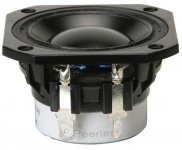
Datasheet: link
Here is results from my first attempt using ath4:
Freestanding axisymmetric with diameter of 320 mm and depth of 198 mm.
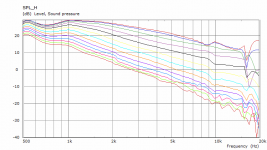
Frequency response 0-90°. 200 points, linearly placed between 20 Hz and 20 kHz.

Frequency response 0-150°. 60 dB scale. Fairly satisfied, only the disturbance around 9 kHz that annoys me.
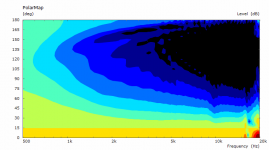
Polar map 0-180°, normalized around 15°. Scale is +20 to -30 dB.
Got a printer yesterday. Will try to print something like this soon.
/Anton
Code:
Source.Contours = {
point p1 0 0 2
point p2 -4 13 2
point p3 -5 13 2
point p4 0 19.75 2
point p5 -1.6 21.25 1
point p6 0 22.75 1
cpoint c1 -23.67 0
cpoint c2 0 21.25
arc p1 c1 p2 1.0
line p2 p3 1.0
line p3 p4 1.0
arc p4 c2 p5 0.75
arc p5 c2 p6 0.25
}
Source.Velocity = 2 ; move in axial direction
Datasheet: link
Here is results from my first attempt using ath4:
Freestanding axisymmetric with diameter of 320 mm and depth of 198 mm.

Frequency response 0-90°. 200 points, linearly placed between 20 Hz and 20 kHz.

Frequency response 0-150°. 60 dB scale. Fairly satisfied, only the disturbance around 9 kHz that annoys me.

Polar map 0-180°, normalized around 15°. Scale is +20 to -30 dB.
Got a printer yesterday. Will try to print something like this soon.
/Anton
Last edited:
They "converge" becaue they are not independent - basically the same recordings were used in both evaluations. It's no wonder they end up being the same and it brings very little to the argument, in my opinion.The fact that Headphones also have a very similar target is a key.
If the preferred PIR and the Headphone target are converging, both on them should also include the "circle of confusion", if that can't be avoided.
I offer a thought experiment:
Mix a recording three times using three different loudspeakers A, B, C * to sound as close as possible and let people subjectively judge the sound of these recordings played on those respective speakers.
* A = flat high-DI; B = flat low-DI; C = flat ON/LW + rising DI
Only the loudspeakers C would have the now "preferred" in-room response. Do you really think that A or B wouldn't sound natural (or any worse than C) when played a recording mixed using them? This just wouldn't make any sense to me. The now "preferred PIR" is nothing more than an attribute of the loudspeaker alone. It can still preserve any spectral balance that is "stored" (mixed in the recording) and "restored" (played back), whatever it is. And this balance would most probably stay the same in all three cases. There could be differences in the way how the recordings were mixed, however, and these would be most interesting to find out, but that would mean to actually get outside of the circle, as suggested, i.e. to make three separate ones and compare those.
Last edited:
I am not sure if this experiment would be enough as you'll still depend on the producer/mixer personal take on the media if you use a single individual.
You would need to "average" the production process to remove this part of the circle.(?)
Plus you would need a wide variety of content to remove that bias too.(?)
Movies sound tracks usually need to follow a controlled standard for production.
The preferred response however looks similar.
You would need to "average" the production process to remove this part of the circle.(?)
Plus you would need a wide variety of content to remove that bias too.(?)
Movies sound tracks usually need to follow a controlled standard for production.
The preferred response however looks similar.
Let's also not forget how this debate started:
There are two perfectly possible targets at the moment, with about the same resulting in-room response:
1) flat ON/LW, rising DI
2) downward-tilted ON/LW, flat DI
The question was what's better. Do we know by now? I don't think so.
And this is not hypothetical - we can make waveguides both ways that are perfectly smooth. So what to choose?
There are two perfectly possible targets at the moment, with about the same resulting in-room response:
1) flat ON/LW, rising DI
2) downward-tilted ON/LW, flat DI
The question was what's better. Do we know by now? I don't think so.
And this is not hypothetical - we can make waveguides both ways that are perfectly smooth. So what to choose?
All I'm saying is that this response is in fact arbitrary.... Movies sound tracks usually need to follow a controlled standard for production.
The preferred response however looks similar.
Thanks. I will also give it a go when I have the optimization loop ready.Here are the measurements of the Peerless PLS-P830970 for use in ath4: [...]
Let's also not forget how this debate started:
There are two perfectly possible targets at the moment, with about the same resulting in-room response:
1) flat ON/LW, rising DI
2) downward-tilted ON/LW, flat DI
The question was what's better. Do we know by now? I don't think so.
The answer to your specific question has not been decided by a valid scientific study, that's true, but as I am sure that you know, based on my research of this problem for decades, that 2) is absolutely the correct answer. Not proven, but also not without a lot of study.
All I'm saying is that this response is in fact arbitrary.
This is true, as you say. What is also true is that to shrink the circle-of-confusion we have to all agree on what this "arbitrary" response actually is. It is arbitrary, but not irrelevant. What we have now is no agreement at all (at least not for audio recordings.) It is highly unlikely that complete agreement would ever follow an extreme situation, so, it seems to me, that adapting Toole's recommendation is as good as we'll ever get.
interesting thing about Toole's work is that it merely confirms Fletcher and Munson's work in that flat response is at 85 to 89 db....
Last edited:
There's really no escaping from the circle of confusion, as they even admit in the conclusion.
There's only one case where the two would "converge" to the same target - if the loudspeakers had a flat DI, otherwise it wouldn't be possible - I don't understand how one could compare the two different target curves for loudspeakers (LW flat/PIR tilted) with only one curve for headphones. The situation is so different IMHO that I doubt that this comparison can actually shed more light into this.
- To me, there's one unanswered question that underlines the whole issue: If we now make a loudspeaker with a flat DI, most of us will then tilt the response(s) downward a bit to sound more neutral in the end. Why? Is this really only the circle of confusion issue or is there a deeper reason? In other words, if there were everywhere only loudspeakers with flat DI, would there still be a need for this downward tilt?
The answer to your specific question has not been decided by a valid scientific study, that's true, but as I am sure that you know, based on my research of this problem for decades, that 2) is absolutely the correct answer. Not proven, but also not without a lot of study.
This is true, as you say. What is also true is that to shrink the circle-of-confusion we have to all agree on what this "arbitrary" response actually is. It is arbitrary, but not irrelevant. What we have now is no agreement at all (at least not for audio recordings.) It is highly unlikely that complete agreement would ever follow an extreme situation, so, it seems to me, that adapting Toole's recommendation is as good as we'll ever get.
Arbitrary it may be but highly correlated with preferences it definitely is.
I don't think that we can expect the causation to be demonstrated though.
From my casual experience, and many people with automated Room Equalizers,
EQing to the preferred PIR alone regardless of the rest of the system is not consistently yielding the preferred performance.
What we think a speaker should be like:
- Reasonably Flat and smooth (no resonances) ON/LW response
- Both on and off axis responses should be similar (i.e. smooth and flattish DI) so that the early and late reflections are similar in tonal balance to the direct sound.
- PIR preferably close to the preferred target
Even enforcing an EQ friendly criterium doesn't add any additional constrains.
Last edited:
What was so cool in the live demo, was that the singer was only source of sound that appeared to be localized with her movement. All backing instruments seemed to be in a constant venue environment.
Imagine how cool it will be for each individual player to be hung in their own acoustic space.....that's moveable! Hello Holodeck 🙂
I hadn't seen the Smyth Audio stuff, thx!
It's an example of what's to come i think, as proaudio implementations take root in home audio deployment. Exciting times !!!!
The big Unity horns do this.
For instance, my Waslo Cosynes would make you *swear* there's a center channel. On good recordings, the singer is in the center and solid as a rock, and the stage stretches from wall to wall.
In my projects with smaller waveguides, there isn't the same effect. Which is why I started messing around with Unity horns flanked by midbasses to extend beamwidth control beyond the point that the waveguide stops doing it's thing.
Spaciousness has a recognized definition in room acoustics, but "envelopment" was coined by Dr. Greisinger (to my knowledge) and doesn't appear in any other room acoustic discussions. For example, no mention of it is made in any of Kuttruff's books on room acoustics. I understand Dr. Greisingers approach and I agree with it, but it is not clear - to me at least - how envelopment is related to spaciousness. They could be the same, but that's not how I read Greisinger.
Just happened to learn there was such a thing as audio wheels today. This one lists Envelopment under Spatial > Localization.
I have a link to the PDF that contains definitions in this post Audio Sound Wheel
In the document they define it as:
Envelopment
Are you surrounded by the reproduced sound and does it give a sense of space around you?
Scale: A little – A lot
I don't know if that is useful but in a different thread people were talking about "High Resolution Speakers" and I had zero idea what that means so I glommed onto this wheel. Unfortunately, the term isn't used in the audio wheel so I still have no idea what it means.
Attachments
Go and listen to the Beolab 90.
The ability to vary the beamwidth will make you wonder how you lived your entire life without this feature.
Alternative to Beolab.
DELTA SenseLab Rapid Speaker Spinner - YouTube
- Home
- Loudspeakers
- Multi-Way
- Acoustic Horn Design – The Easy Way (Ath4)
